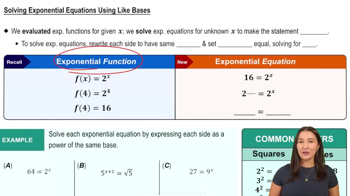Table of contents
- 0. Review of Algebra4h 16m
- 1. Equations & Inequalities3h 18m
- 2. Graphs of Equations43m
- 3. Functions2h 17m
- 4. Polynomial Functions1h 44m
- 5. Rational Functions1h 23m
- 6. Exponential & Logarithmic Functions2h 28m
- 7. Systems of Equations & Matrices4h 6m
- 8. Conic Sections2h 23m
- 9. Sequences, Series, & Induction1h 19m
- 10. Combinatorics & Probability1h 45m
6. Exponential & Logarithmic Functions
Solving Exponential and Logarithmic Equations
Problem 65c
Textbook Question
Solve each equation. Give solutions in exact form. See Examples 5–9. log_8 (x + 2) + log_8 (x + 4) = log_8 8
 Verified step by step guidance
Verified step by step guidance1
<Combine the logarithms on the left side using the product rule: \( \log_b(m) + \log_b(n) = \log_b(m \cdot n) \).>
<This gives us: \( \log_8((x + 2)(x + 4)) = \log_8 8 \).>
<Since the logarithms are equal, set the arguments equal to each other: \((x + 2)(x + 4) = 8\).>
<Expand the left side: \(x^2 + 6x + 8 = 8\).>
<Subtract 8 from both sides to set the equation to zero: \(x^2 + 6x = 0\).>
Recommended similar problem, with video answer:
 Verified Solution
Verified SolutionThis video solution was recommended by our tutors as helpful for the problem above
Video duration:
5mPlay a video:
Was this helpful?
Key Concepts
Here are the essential concepts you must grasp in order to answer the question correctly.
Logarithmic Properties
Understanding the properties of logarithms is essential for solving logarithmic equations. Key properties include the product rule, which states that log_b(m) + log_b(n) = log_b(m*n), and the fact that log_b(b) = 1. These properties allow us to combine or simplify logarithmic expressions, making it easier to isolate the variable.
Recommended video:

Change of Base Property
Change of Base Formula
The change of base formula is useful when dealing with logarithms of different bases. It states that log_b(a) can be expressed as log_k(a) / log_k(b) for any positive k. This concept is particularly helpful when the base of the logarithm is not easily manageable, allowing for conversion to a more familiar base, such as 10 or e.
Recommended video:

Change of Base Property
Exponential Equations
Solving logarithmic equations often involves converting them into exponential form. For example, if log_b(a) = c, then a = b^c. This understanding is crucial for finding the values of x in logarithmic equations, as it allows us to express the logarithmic equation in a more straightforward algebraic form that can be solved for the variable.
Recommended video:

Solving Exponential Equations Using Logs

 4:46m
4:46mWatch next
Master Solving Exponential Equations Using Like Bases with a bite sized video explanation from Callie
Start learningRelated Videos
Related Practice












